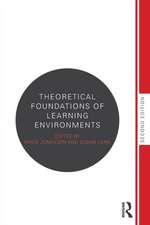Design for Learning in Virtual Worlds: Interdisciplinary Approaches to Educational Technology
Autor Brian C. Nelson, Benjamin E. Erlandsonen Limba Engleză Paperback – 8 mar 2012
• the history and evolution of virtual worlds
• the theories behind the use of virtual worlds for learning
• the design of curricula in virtual worlds
• design guidelines for elements experienced in virtual worlds that support learning
• design guidelines for learning quests and activities in virtual worlds.
The authors also examine the theories and associated design principles used to create embedded assessments in virtual worlds. Finally, a framework and methodology is provided to assist professionals in evaluating "off-the-shelf" virtual worlds for use in educational and training settings. Design for Learning in Virtual Worlds will be invaluable both as a professional resource and as a textbook for courses within Educational Technology, Learning Sciences, and Library Media programs that focus on gaming or online learning environments.
| Toate formatele și edițiile | Preț | Express |
|---|---|---|
| Paperback (1) | 305.52 lei 43-57 zile | |
| Taylor & Francis – 8 mar 2012 | 305.52 lei 43-57 zile | |
| Hardback (1) | 822.54 lei 43-57 zile | |
| Taylor & Francis – 8 mar 2012 | 822.54 lei 43-57 zile |
Preț: 305.52 lei
Preț vechi: 348.85 lei
-12% Nou
Puncte Express: 458
Preț estimativ în valută:
58.46€ • 61.19$ • 48.66£
58.46€ • 61.19$ • 48.66£
Carte tipărită la comandă
Livrare economică 31 martie-14 aprilie
Preluare comenzi: 021 569.72.76
Specificații
ISBN-13: 9780415886406
ISBN-10: 0415886406
Pagini: 240
Ilustrații: 8 tables and 50 line drawings
Dimensiuni: 178 x 254 x 13 mm
Greutate: 0.43 kg
Ediția:New.
Editura: Taylor & Francis
Colecția Routledge
Seria Interdisciplinary Approaches to Educational Technology
Locul publicării:Oxford, United Kingdom
ISBN-10: 0415886406
Pagini: 240
Ilustrații: 8 tables and 50 line drawings
Dimensiuni: 178 x 254 x 13 mm
Greutate: 0.43 kg
Ediția:New.
Editura: Taylor & Francis
Colecția Routledge
Seria Interdisciplinary Approaches to Educational Technology
Locul publicării:Oxford, United Kingdom
Notă biografică
Brian C. Nelsonis Associate Professor of Educational Technology at Arizona State University. An instructional designer and learning theorist, he has published and presented extensively on the viability of educational virtual worlds for situated inquiry learning and assessment. Dr. Nelson’s recent writing addresses issues related to the design and evaluation of educational games, with a focus on theory-based design principles. He is currently a Co-Principal Investigator on the SAVE Science Virtual World project, and was the Project Designer on the River City project. He was a Co-Principal Investigator on two MacArthur Foundation Digital Learning grants and was also a Co-Principal Investigator on the SURGE project, creating video games to teach high school physics.
Benjamin E. Erlandson is Assistant Professor of Instructional Science and Technology with an emphasis in Digital Media in the School of Information, Technology, and Communication Design (ITCD) at California State University, Monterey Bay. In addition to teaching several courses in interactive media design/development and instructional design, Dr. Erlandson runs the Virtual Environments for Situated Inquiry of Complexity (VESIC) Lab, conducting various research studies investigating the usefulness of meso-immersive 2D and 3D virtual environments—much like those used for many popular computer games—for learning about complex systems.
Benjamin E. Erlandson is Assistant Professor of Instructional Science and Technology with an emphasis in Digital Media in the School of Information, Technology, and Communication Design (ITCD) at California State University, Monterey Bay. In addition to teaching several courses in interactive media design/development and instructional design, Dr. Erlandson runs the Virtual Environments for Situated Inquiry of Complexity (VESIC) Lab, conducting various research studies investigating the usefulness of meso-immersive 2D and 3D virtual environments—much like those used for many popular computer games—for learning about complex systems.
Cuprins
PART I — INTRODUCTION AND OVERVIEW Chapter 1: Definition and History of Virtual Worlds for Education What’s a virtual world? A (Very) Brief History of Educational Virtual Worlds Conclusion Test your understanding Learning Activities References Links Other Resources Chapter 2: Mechanics of Virtual Worlds: The World Introduction The World Where is the World? Living on the Edge Multiple Worlds Networked Worlds Conclusion Test Your Understanding Learning Activities Links Other Resources Chapter 3: Mechanics of Virtual Worlds: The GUI Introduction The World and The GUI Defined The GUI What the GUI Is What the GUI Isn't How Does the GUI Work? Between the GUI and the World Conclusion Test your Understanding Learning Activities Other Resources PART 2 — THEORETICAL BASIS FOR LEARNING AND ASSESSMENT IN VIRTUAL WORLDS Chapter 4: Theoretical Basis for Learning in Virtual Worlds Introduction Theoretical basis for learning in virtual worlds Conclusion Test your understanding Learning Activities References Links Other Resources Chapter 5: Defining the Context of Virtual Worlds Introduction, Subject Domain, Learner Population World Boundaries Participant Roles Conclusion Test Your Understanding Learning Activities References Other Resources Chapter 6: Measurement and Assessment with Virtual Worlds Introduction Measurement and Assessment Reliability and Validity Choosing Constructs to be Measured in Virtual Worlds Conclusion Test Your Understanding Learning Activities References Other Resources PART III — THEORETICAL PERSPECTIVES: DESIGN FOR LEARNING IN VIRTUAL WORLDS Chapter 7: Critiquing Virtual Worlds and Virtual World-based Curricula Introduction, Critiquing Virtual Worlds Conclusion Test your understanding Learning Activities References Links Other Resources Chapter 8: Designing Curricula for Virtual Worlds Introduction, Virtual World Curriculum Design Document, Part 1: Design Overview Part 2: Design Details Conclusion, Test your understanding Learning
Descriere
This text explores the history and evolution of virtual worlds, the theories behind the use of virtual worlds for learning, the design of curricula in virtual worlds, design guidelines for elements experienced in virtual worlds that support learning.













